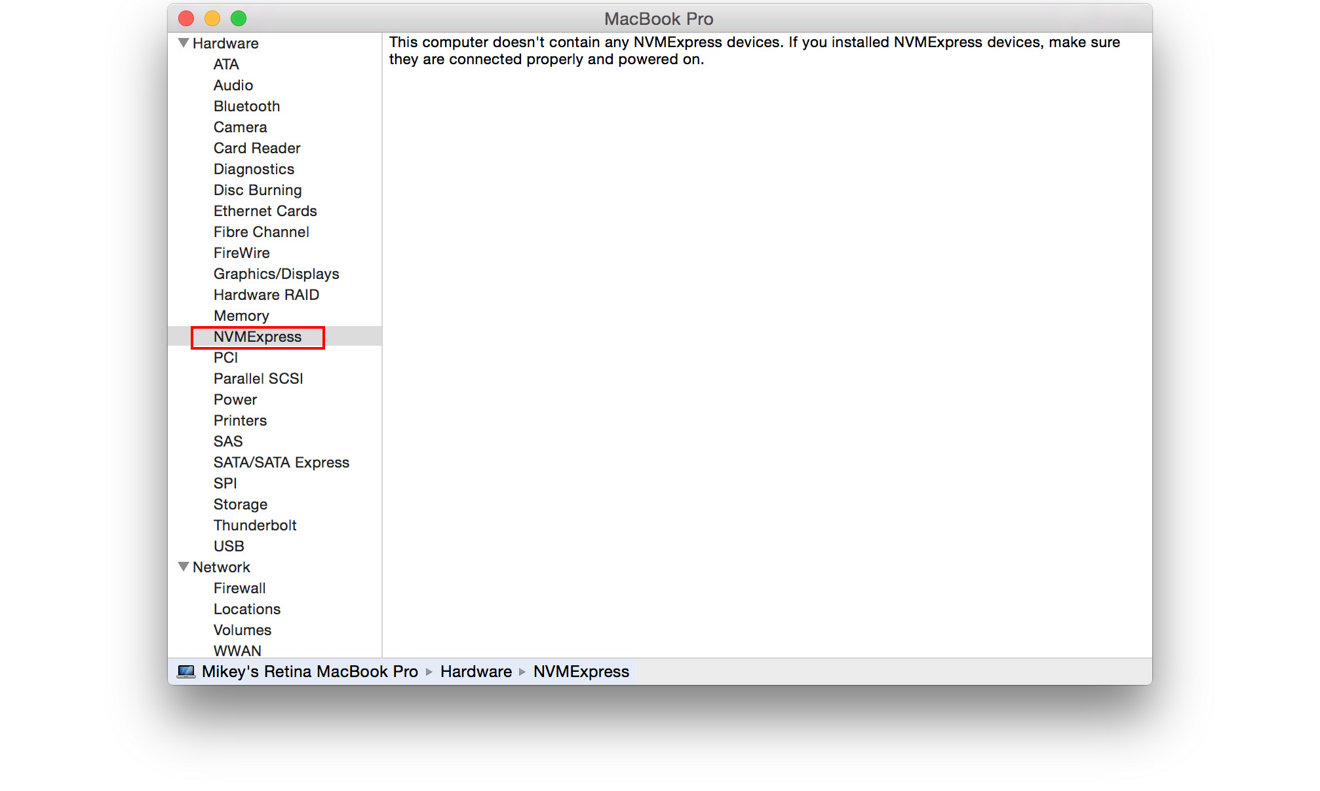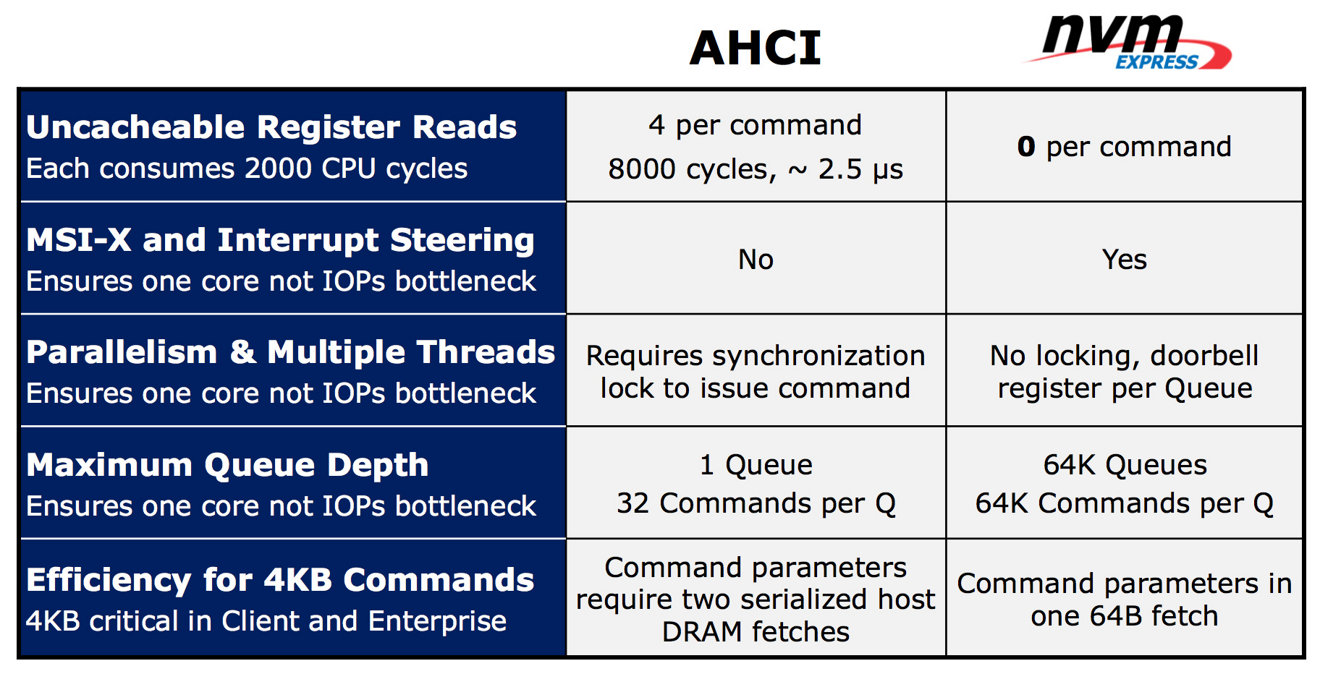Looking to take full advantage of PCI Express solid state drives found in the latest Mac models, including the new 12-inch MacBook, Apple built support for the NVM Express SSD Interface into its most recent OS X 10.10.3 Yosemite update.
Apple's all-new Photos app stole the spotlight when OS X 10.10.3 was released earlier this week, but the update brought a host of backend upgrades to bring parity between software and cutting edge hardware.
One of the more interesting additions is NVMe, a highly optimized PCIe-based protocol that promises faster SSD performance than current AHCI (Advanced Host Controller Interface) implementations. According to the protocol's webpage, NVMe is a register interface, command set and feature set developed "to unlock the potential of PCIe SSDs now and in the future, and standardize the PCIe SSD interface."
After updating to OS X 10.10.3, the new capability shows up in the hardware section of a Mac's System Report, though owners of older MacBook models are unlikely to see supported drives. The addition was spotted by MacRumors on Saturday.
Developed by an industry consortium including major industry players like Intel, NVMe is meant to replace aging AHCI technology, which was designed to maximize performance in systems using spinning hard drives. As noted by AnandTech, NVMe is optimized for lower latency operations afforded by solid state media, or non-volatile memory. Compared to AHCI, NVMe reduces latency by 50 percent. For example, Intel puts latency overhead in SCSI/SAS systems at 6 nanoseconds at 19,500 cycles, but quotes NVMe at 2.8 nanoseconds at 9,100 cycles (PDF link).
Further, NVMe is designed to scale over the next decade, a lifecycle comparable to AHCI, which was introduced in 2004. And since Apple has been using the PCIe transport protocol since 2011, the company is in a good position to expeditiously roll out support across the entire Mac lineup.
The first Mac to take advantage of NVMe speed — and accompanying power savings — is Apple's newly released 12-inch MacBook with Retina display. Apple pulled a similar move when it introduced PCIe with the 2011 MacBook Air, a laptop designed with an eye on efficiency, not speed.
 AppleInsider Staff
AppleInsider Staff


-m.jpg)






 Andrew O'Hara
Andrew O'Hara
 Wesley Hilliard
Wesley Hilliard

 Malcolm Owen
Malcolm Owen
 Marko Zivkovic
Marko Zivkovic

 Chip Loder
Chip Loder
 Christine McKee
Christine McKee




-m.jpg)




56 Comments
Intel has some awesome new NVM Express SSDs for the PC. The 750 Series gets 2400MB/s read and 1200MB/s write. [IMG ALT=""]http://forums.appleinsider.com/content/type/61/id/57804/width/500/height/1000[/IMG] Another change in 10.10.3 is massively improved support for 3rd party 4k monitors. If you look at Apple's 4K support page, they used to list a small set of supported monitors, but now they just say with OS X Yosemite v10.10.3 "most" 4K SST and MST monitors are supported. https://support.apple.com/en-au/HT202856 Edit: also, something else I just noticed on the Apple 4K page - the Dell UP2715K 27-inch 5K display is now officially supported on the Mac Pro, so they don't have to be jealous of 5K iMac owners any more.
[quote name="ascii" url="/t/185727/apple-enables-nvm-express-protocol-for-faster-ssd-performance-with-os-x-10-10-3#post_2708541"]Intel has some awesome new NVM Express SSDs for the PC. The 750 Series gets 2400MB/s read and 1200MB/s write. [IMG ALT=""]http://forums.appleinsider.com/content/type/61/id/57804/width/500/height/1000[/IMG] Another change in 10.10.3 is massively improved support for 3rd party 4k monitors. If you look at Apple's 4K support page, they used to list a small set of supported monitors, but now they just say with OS X Yosemite v10.10.3 "most" 4K SST and MST monitors are supported. https://support.apple.com/en-au/HT202856 Edit: also, something else I just noticed on the Apple 4K page - the Dell UP2715K 27-inch 5K display is now officially supported on the Mac Pro, so they don't have to be jealous of 5K iMac owners any more.[/quote] Would love for someone to review this on a MacPro. I would snatch it up today.
[quote name="aplnub" url="/t/185727/apple-enables-nvm-express-protocol-for-faster-ssd-performance-with-os-x-10-10-3#post_2708556"] Would love for someone to review this on a MacPro. I would snatch it up today.[/quote] Unfortunately this wouldn't fit into a Mac Pro due to lack of full-size PCIe sockets, unless Intel makes one of these with a compatible connector...
Compared to AHCI, NVMe reduces latency by 50 percent. For example, Intel puts latency overhead in SCSI/SAS systems at 6 nanoseconds at 19,500 cycles, but quotes NVMe at 2.8 nanoseconds at 9,100 cycles (PDF link).
Both uses of "nanoseconds" should be "microseconds", as indicated on page 9 of the linked PDF file.
Lordy I wish I had a legitimate reason to upgrade my Late 2012 iMac. Well, a reason other than, "I just want a newer, better one." I did say legitimate after all. :)